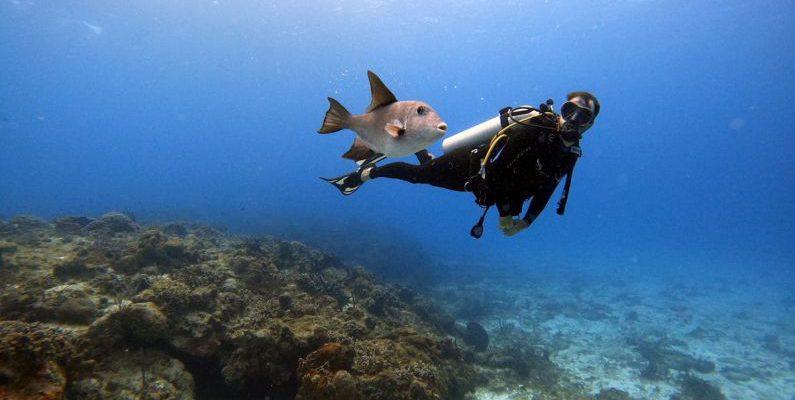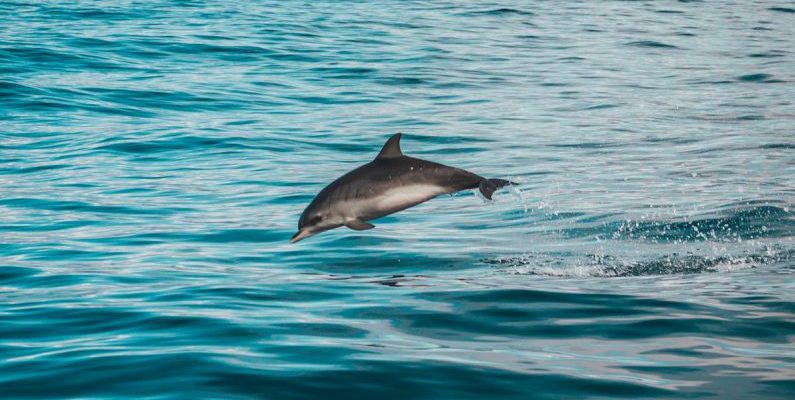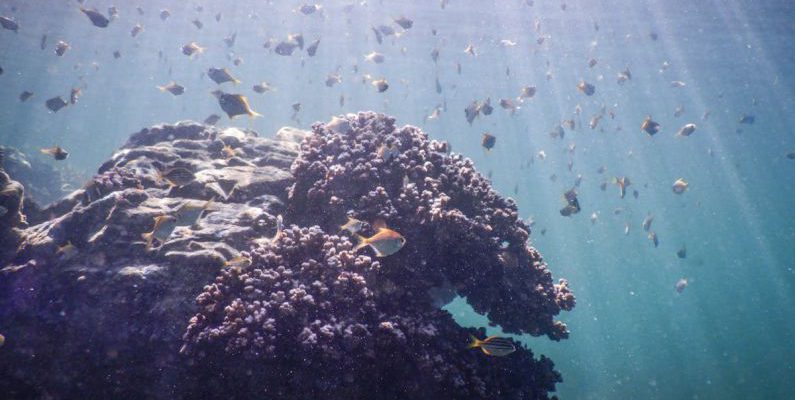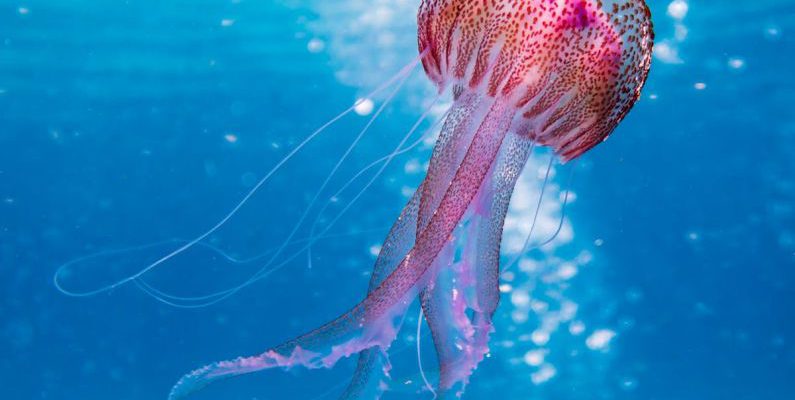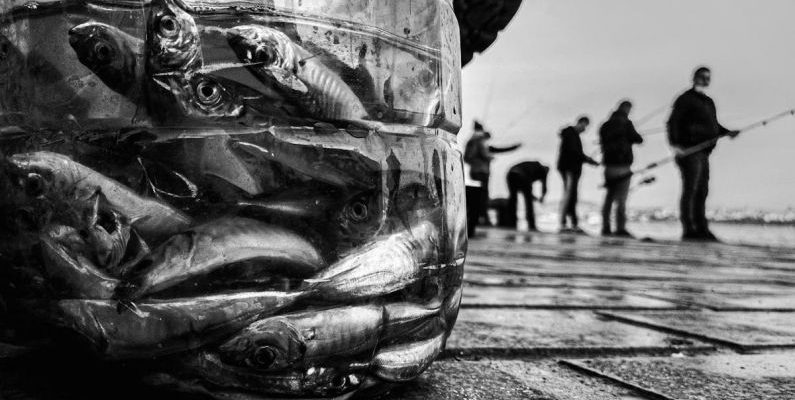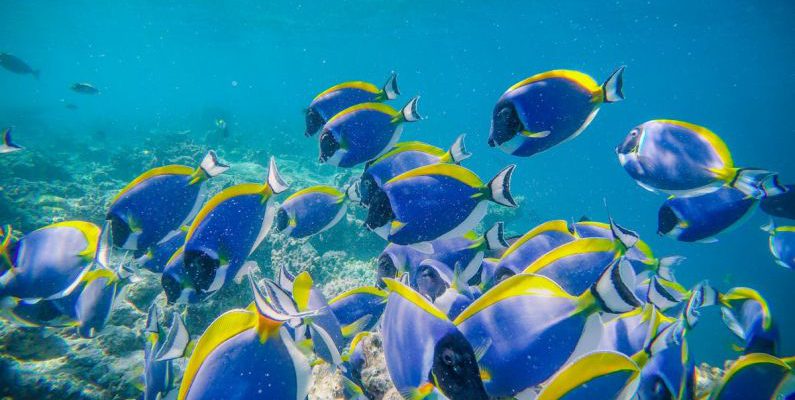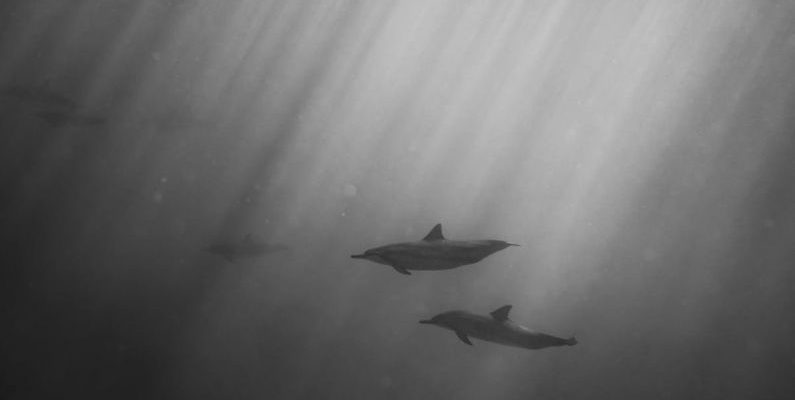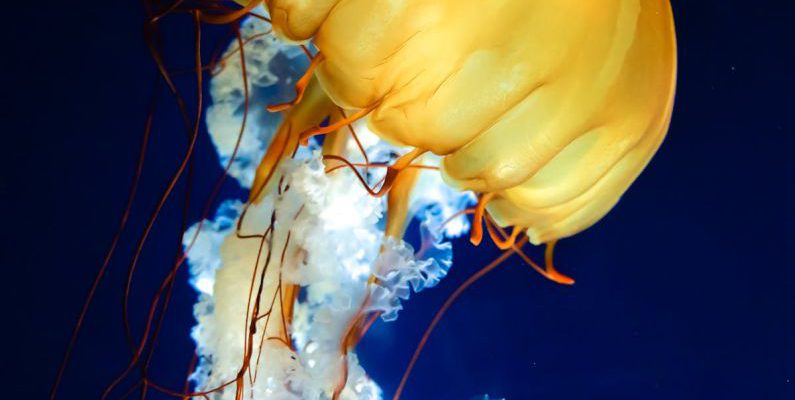Nestled in the crystal-clear waters of the Caribbean Sea lies a diver's paradise known as Cozumel. This Mexican island boasts some of the most spectacular underwater landscapes in the world, making it a must-visit destination for diving enthusiasts. From vibrant coral reefs teeming with marine life to unique underwater formations, Cozumel offers a truly unforgettable experience for divers of all levels. Whether you're a seasoned pro or a novice looking to explore the beauty beneath the waves, Cozumel has something to offer everyone.
**The Reefs of Cozumel**
Cozumel is renowned for its stunning coral reefs, which are considered some of the healthiest in the Caribbean. The island's reefs are home to a diverse array of marine life, including colorful fish, sea turtles, rays, and even the occasional whale shark. Divers can explore these vibrant ecosystems and witness firsthand the beauty and biodiversity that thrives beneath the surface. Some of the most popular dive sites in Cozumel include Palancar Reef, Santa Rosa Wall, and Punta Sur, each offering its own unique underwater landscapes and marine encounters.
**Visibility and Water Conditions**
One of the many reasons why Cozumel is a top diving destination is its exceptional visibility and water conditions. With visibility often exceeding 100 feet, divers can enjoy crystal-clear waters that allow for unparalleled views of the underwater world. The warm water temperatures, typically ranging from 77°F to 82°F, make diving in Cozumel comfortable year-round. The island's currents provide both drift diving opportunities for more experienced divers and gentle conditions for those just starting out. Whether you prefer exploring shallow reefs or venturing into deeper waters, Cozumel offers a variety of dive sites suitable for all preferences.
**Marine Life Encounters**
Diving in Cozumel offers the chance to encounter a wide variety of marine life up close. From schools of colorful tropical fish to larger species like nurse sharks and eagle rays, divers are bound to have unforgettable encounters with creatures both big and small. Cozumel is also known for its resident population of splendid toadfish, a unique species found only in the waters surrounding the island. With so much marine life to discover, each dive in Cozumel promises new and exciting encounters beneath the waves.
**Dive Shops and Services**
For those looking to explore the underwater wonders of Cozumel, there are numerous dive shops and operators on the island that cater to divers of all levels. Whether you need to rent equipment, book guided dives, or complete a certification course, the dive shops in Cozumel offer a range of services to ensure a safe and enjoyable diving experience. Many dive operators also provide transportation to and from dive sites, making it easy for visitors to explore the best that Cozumel has to offer beneath the surface.
**Preservation and Conservation**
As a popular diving destination, Cozumel places a strong emphasis on preservation and conservation efforts to protect its marine ecosystems. The island is part of the Mesoamerican Reef System, the second-largest coral reef system in the world, making it crucial to safeguard its delicate habitats. Divers visiting Cozumel are encouraged to follow sustainable diving practices, such as avoiding touching or disturbing marine life, using reef-safe sunscreen, and supporting local conservation initiatives. By respecting the marine environment, divers can help ensure that future generations can continue to enjoy the beauty of Cozumel's underwater treasure.
**Exploring Cozumel Above Water**
While Cozumel is primarily known for its exceptional diving opportunities, the island also offers plenty to see and do above water. Visitors can explore the charming town of San Miguel, with its colorful streets, lively markets, and delicious local cuisine. Nature enthusiasts can venture into the island's lush jungles and discover ancient Mayan ruins hidden amidst the verdant landscape. Whether you're seeking adventure on land or beneath the waves, Cozumel promises a truly unforgettable experience for all who visit.
**Unveiling Cozumel's Underwater Beauty**
Cozumel's underwater treasure is a world waiting to be explored, offering divers a glimpse into the breathtaking beauty of the Caribbean Sea. With its vibrant coral reefs, diverse marine life, and exceptional water conditions, Cozumel is a diver's paradise that beckons to be discovered. Whether you're drawn to the colorful fish darting among the corals or the thrill of drifting along underwater walls, Cozumel holds endless opportunities for underwater adventure. Immerse yourself in the wonders of Cozumel's underwater world and experience firsthand the magic that awaits beneath the surface.
Author: diveholidayisle
In Eco Diving
Diving is a thrilling and unique experience that allows individuals to explore the mesmerizing underwater world. Whether you are a beginner or an experienced diver, it is essential to prioritize safety and environmental responsibility while diving. Practicing responsible diving not only ensures your safety but also helps protect the delicate marine ecosystems. In this article, we will discuss guidelines and tips to help you become a more responsible diver.
### Understanding Your Impact
Before you embark on a diving adventure, it is crucial to understand the impact that divers can have on marine environments. Marine ecosystems are fragile, and even small disturbances can have a significant impact on the delicate balance of underwater life. As a responsible diver, it is your duty to minimize your impact on the environment and marine life.### Respect Marine Life
One of the fundamental principles of responsible diving is to respect marine life. Avoid touching, chasing, or disturbing marine creatures in their natural habitat. Remember that you are a guest in their home, and it is essential to observe them from a respectful distance. Resist the temptation to collect souvenirs or artifacts from the ocean floor, as this can disrupt the ecosystem.### Dive Within Your Limits
Safety should always be a top priority when diving. Before entering the water, ensure that you are properly trained and certified for the dive you are undertaking. Dive within your limits and do not attempt dives that are beyond your skill level. Always dive with a buddy and follow the instructions of your dive leader to ensure a safe and enjoyable experience.### Practice Good Buoyancy Control
Maintaining good buoyancy control is not only essential for your safety but also helps protect the delicate marine environment. Proper buoyancy control allows you to move through the water without damaging coral reefs or stirring up sediment. Practice buoyancy control techniques regularly to improve your skills and minimize your impact on the underwater ecosystem.### Dispose of Waste Properly
One of the key principles of responsible diving is to leave no trace behind. Avoid littering or discarding any waste into the ocean. Dispose of any trash or debris properly when you are back on the boat or on land. Consider participating in beach clean-up initiatives to help keep our oceans clean and free of pollution.### Choose Eco-Friendly Dive Operators
When selecting a dive operator for your underwater adventures, choose companies that prioritize environmental sustainability. Eco-friendly dive operators follow practices that minimize their impact on the environment, such as using reef-safe sunscreen, avoiding anchoring on coral reefs, and supporting marine conservation initiatives. By supporting eco-friendly dive operators, you are contributing to the protection of marine ecosystems.### Stay Informed and Educated
Continuing education is key to becoming a more responsible diver. Stay informed about the latest developments in diving practices and marine conservation efforts. Take courses on environmental awareness and marine conservation to deepen your understanding of the issues facing our oceans. By educating yourself, you can become a more informed and conscientious diver.### Conclusion: Dive Responsibly for a Sustainable Future
In conclusion, practicing responsible diving is essential for the safety of divers and the preservation of marine ecosystems. By following the guidelines and tips outlined in this article, you can become a more responsible and environmentally conscious diver. Remember to respect marine life, dive within your limits, practice good buoyancy control, dispose of waste properly, choose eco-friendly dive operators, and stay informed and educated. Together, we can ensure a sustainable future for our oceans and marine life. Dive responsibly and make a positive impact on the underwater world.
In Dive Sites
Nestled in the western Pacific Ocean lies a hidden gem for divers seeking unparalleled underwater adventures – Palau. With its crystal-clear waters, diverse marine life, and stunning coral reefs, Palau is truly a diver's dream destination. This pristine archipelago offers a unique opportunity to explore some of the most biodiverse waters in the world, making it a must-visit destination for any diving enthusiast.
The Underwater Wonderland of Palau
Palau is renowned for its breathtaking underwater landscapes that captivate divers from around the globe. The archipelago is home to an abundance of dive sites, each offering a distinct and awe-inspiring experience. From vibrant coral gardens teeming with colorful fish to dramatic drop-offs and underwater caves, Palau's underwater world is a true wonderland waiting to be explored. One of the most famous dive sites in Palau is Blue Corner, known for its strong currents and impressive marine life. Divers here can witness schools of barracuda, sharks, and eagle rays cruising along the reef, creating a mesmerizing spectacle. Another must-visit site is the German Channel, where divers can encounter manta rays gliding gracefully through the water, providing an unforgettable experience. For those seeking a unique adventure, Palau also offers the opportunity to dive with jellyfish in Jellyfish Lake. This magical experience allows divers to swim among thousands of harmless jellyfish, creating a surreal and unforgettable encounter with nature. Palau's diverse dive sites cater to all levels of divers, from beginners to experienced professionals, ensuring that everyone can experience the beauty of its underwater world.Conservation and Sustainability Efforts
Palau is not only a paradise for divers but also a pioneer in marine conservation and sustainability efforts. The archipelago has taken significant steps to protect its marine environment, including establishing marine protected areas and implementing strict regulations to preserve its delicate ecosystems. Palau was one of the first countries to declare its entire exclusive economic zone a shark sanctuary, demonstrating its commitment to marine conservation. In addition to its conservation efforts, Palau has also banned harmful practices such as shark finning and has implemented eco-friendly tourism practices to minimize the impact on its marine environment. By promoting sustainable diving practices and responsible tourism, Palau is setting an example for other destinations around the world to follow.Beyond Diving: Exploring Palau's Natural Beauty
While Palau is a diver's paradise, the archipelago offers much more than just underwater adventures. Visitors can explore its lush jungles, pristine beaches, and vibrant cultural sites, providing a diverse range of activities for nature enthusiasts. From hiking to waterfalls and kayaking through mangrove forests to learning about the traditional customs of the Palauan people, there is no shortage of experiences to be had on land. Visitors to Palau can also immerse themselves in its rich history by visiting sites such as the ancient stone monoliths of Badrulchau or the WWII relics scattered across the islands. By exploring the cultural and historical heritage of Palau, visitors can gain a deeper appreciation for the archipelago and its people.A Sustainable Future for Palau
As Palau continues to attract visitors from around the world, the archipelago remains committed to preserving its natural beauty and cultural heritage for future generations. By prioritizing conservation efforts, promoting sustainable tourism practices, and embracing its unique identity, Palau is poised to remain a premier destination for divers and nature lovers alike. With its unparalleled underwater landscapes, commitment to conservation, and diverse range of activities, Palau truly stands out as a diver's dream destination. Whether exploring its vibrant coral reefs, diving with jellyfish, or immersing oneself in its cultural heritage, Palau offers a once-in-a-lifetime experience that will leave a lasting impression on all who visit.
In Eco Diving
Artificial reefs have become increasingly popular around the world due to their numerous benefits for marine ecosystems and coastal communities. These man-made structures serve as habitats for a variety of marine life, enhance biodiversity, protect coastlines, and provide opportunities for research and eco-tourism. In this article, we will delve into the fascinating world of artificial reefs and explore the many advantages they offer.
Enhancing Marine Biodiversity
Artificial reefs play a crucial role in enhancing marine biodiversity by providing new habitats for a wide range of marine species. These structures attract fish, corals, sponges, and other marine organisms, creating thriving ecosystems in areas that were previously devoid of such diversity. By increasing the availability of suitable habitats, artificial reefs help support the growth of fish populations and contribute to the overall health of marine ecosystems.Protecting Coastlines
One of the key benefits of artificial reefs is their ability to protect coastlines from erosion and storm damage. These structures can dissipate wave energy, reducing the impact of strong currents and preventing erosion along vulnerable shorelines. By acting as barriers, artificial reefs help stabilize coastal areas and mitigate the effects of rising sea levels and increasingly severe weather events. In this way, these man-made structures play a vital role in coastal protection and management.Boosting Fisheries
Artificial reefs also have a significant impact on local fisheries by providing additional habitats for fish to breed, feed, and seek shelter. By attracting fish populations to specific areas, artificial reefs can help increase fish stocks and support sustainable fishing practices. Fishermen benefit from the presence of artificial reefs as these structures create hotspots for fishing, resulting in higher catches and improved livelihoods. Furthermore, the establishment of artificial reefs can reduce pressure on natural reef systems, allowing them to recover and thrive.Promoting Tourism and Recreation
Artificial reefs have the potential to attract tourists and recreational divers, providing economic opportunities for coastal communities. These man-made structures create underwater environments that are ideal for diving, snorkeling, and marine tourism activities. Tourists are drawn to artificial reefs to explore the diverse marine life that inhabits these structures, offering a unique and captivating underwater experience. By promoting eco-tourism, artificial reefs can stimulate local economies and support sustainable development in coastal regions.Facilitating Research and Education
Artificial reefs serve as valuable sites for scientific research and environmental education. Researchers can study the ecological processes and interactions taking place on artificial reefs, gaining insights into marine ecosystem dynamics and biodiversity. These structures also provide a hands-on learning opportunity for students and educators, allowing them to observe marine life up close and learn about the importance of reef conservation. By serving as outdoor classrooms, artificial reefs help raise awareness about marine conservation and inspire future generations to protect our oceans. In conclusion, artificial reefs offer a wide range of benefits for marine ecosystems, coastal communities, and the environment as a whole. From enhancing biodiversity and protecting coastlines to boosting fisheries and promoting tourism, these man-made structures play a crucial role in supporting marine life and sustainable development. By recognizing the value of artificial reefs and investing in their creation and maintenance, we can harness their potential to create thriving marine habitats and ensure a healthy future for our oceans.
In Dive Sites
The Cayman Islands: a Scuba Diving Haven
Nestled in the crystal-clear waters of the Caribbean Sea, the Cayman Islands are a scuba diver's paradise. With their vibrant coral reefs, abundant marine life, and impressive underwater landscapes, these islands offer some of the best diving experiences in the world. Whether you are a seasoned diver or a beginner looking to explore the underwater world for the first time, the Cayman Islands have something to offer for everyone.Dive into Crystal Clear Waters
One of the main reasons why the Cayman Islands are such a popular destination for scuba diving is the exceptional visibility of their waters. With visibility often exceeding 100 feet, divers are treated to a surreal underwater experience where they can see clearly for vast distances. This crystal-clear water is a result of the islands' pristine marine environment and the absence of pollution, making it an ideal setting for underwater exploration.Explore Vibrant Coral Reefs
The Cayman Islands are home to a diverse array of coral reefs, teeming with life and color. From delicate sea fans swaying in the current to massive brain corals providing shelter for a variety of fish species, the underwater landscapes here are truly breathtaking. Divers can swim among schools of tropical fish, spot elusive sea turtles gliding gracefully through the water, and marvel at the intricate beauty of the coral formations that dot the seabed. These vibrant reefs are a testament to the islands' commitment to marine conservation and provide a rich ecosystem for divers to discover.Encounter Abundant Marine Life
In addition to the colorful coral reefs, the waters surrounding the Cayman Islands are home to a wide variety of marine life. Divers can encounter majestic eagle rays soaring through the water, playful dolphins frolicking in the waves, and sleek barracudas patrolling the reef. The islands' diverse marine ecosystem supports a wealth of species, from tiny seahorses hiding among the coral to massive whale sharks passing through on their migratory routes. With such abundant marine life, every dive in the Cayman Islands offers the opportunity for exciting encounters and unforgettable experiences.Experience Unique Dive Sites
The Cayman Islands boast a range of dive sites that cater to divers of all experience levels. From shallow reefs suitable for beginners to deep walls and wrecks that challenge even the most seasoned divers, there is no shortage of options to explore. One of the most famous dive sites in the Cayman Islands is the USS Kittiwake, a sunken submarine rescue vessel that now serves as an artificial reef teeming with marine life. Another popular spot is the Bloody Bay Wall off Little Cayman, where divers can descend along a sheer drop-off that plunges into the depths of the ocean, offering a thrilling and unforgettable dive experience.Immerse Yourself in Island Culture
In addition to its world-class diving opportunities, the Cayman Islands also offer a rich cultural experience for visitors. From sampling local cuisine at seaside restaurants to exploring the islands' historic sites and vibrant markets, there is no shortage of things to see and do above water. Whether you choose to relax on the pristine beaches, embark on a snorkeling adventure, or soak up the sun on a boat tour, the Cayman Islands have something for everyone to enjoy. In conclusion, the Cayman Islands are a scuba diving haven that offers an unparalleled underwater experience for divers of all levels. With their crystal-clear waters, vibrant coral reefs, abundant marine life, and unique dive sites, these islands are a must-visit destination for anyone looking to explore the wonders of the deep blue sea. So pack your gear, book your trip, and get ready to dive into a world of adventure in the beautiful waters of the Cayman Islands.
In Eco Diving
The vast expanse of the world's oceans holds many mysteries, but one particularly insidious problem lurks beneath the surface: ghost fishing. This silent killer threatens marine life and disrupts the delicate balance of marine ecosystems. From abandoned fishing gear to lost traps and nets, ghost fishing poses a significant threat to the health of our oceans. Understanding the impact of this issue is crucial in finding solutions to mitigate its effects and protect our marine environment.
The Dangers of Abandoned Fishing Gear
Abandoned or lost fishing gear, such as nets, traps, and lines, continue to catch marine life long after they have been discarded. These ghost nets drift with the currents, trapping fish, seabirds, turtles, and other marine animals in a deadly cycle. The trapped animals struggle to escape, often leading to injury, suffocation, or starvation. This not only causes immense suffering to the animals but also disrupts the natural food chain and ecosystem dynamics.The Persistence of Ghost Fishing
Unlike traditional fishing activities where the catch is retrieved by fishermen, ghost fishing continues indefinitely as long as the abandoned gear remains in the water. The durability of modern fishing gear means that it can persist in the marine environment for years, continuing to catch and kill marine life long after it was lost or discarded. This perpetual cycle of ghost fishing can have devastating consequences on fish populations and marine biodiversity.Impact on Marine Ecosystems
Ghost fishing not only affects individual marine animals but also has broader implications for marine ecosystems. As ghost nets and gear continue to trap and kill marine life, they can disrupt the balance of marine food webs and habitats. By indiscriminately catching a wide range of species, ghost fishing can lead to population declines, loss of biodiversity, and even ecosystem collapse in some cases. The cumulative impact of ghost fishing can have far-reaching consequences for the health and resilience of marine ecosystems.Efforts to Combat Ghost Fishing
Recognizing the urgent need to address the issue of ghost fishing, various organizations, governments, and conservation groups have initiated efforts to combat this silent killer. One approach involves the removal of ghost gear from the oceans through organized clean-up operations. By retrieving abandoned fishing gear, these initiatives aim to reduce the immediate threat to marine life and prevent further damage to marine ecosystems. Additionally, raising awareness about the impact of ghost fishing and promoting responsible fishing practices can help prevent the problem at its source.Technological Innovations and Solutions
Innovations in technology are also playing a crucial role in combating ghost fishing. GPS tracking systems and biodegradable fishing gear are being developed to help monitor and reduce the impact of lost or abandoned gear in the oceans. By tracking the movement of fishing gear and designing gear that degrades over time, researchers and industry professionals are working towards more sustainable fishing practices that minimize the risk of ghost fishing. These technological solutions offer promising avenues for addressing the root causes of ghost fishing and promoting environmentally friendly fishing practices.Safeguarding Our Oceans for the Future
As we strive to protect our oceans and marine life for future generations, addressing the issue of ghost fishing is paramount. By understanding the dangers posed by abandoned fishing gear and taking proactive measures to prevent ghost fishing, we can help preserve the health and biodiversity of our oceans. Through collaborative efforts, innovative solutions, and a commitment to sustainable fishing practices, we can work towards a future where ghost fishing is no longer a silent killer in the seas.
Imagine the feeling of weightlessness as you descend into the depths of the ocean, surrounded by a world of mystery and beauty. The underwater realm is a place of wonder, where colorful marine life dances before your eyes and ancient shipwrecks lay silent witnesses to the passage of time. However, beneath the tranquil surface lies a challenging environment that demands respect and skill to navigate. In the thrilling world of underwater exploration, one must be prepared for the unexpected, ready to face the challenges that come with the territory. This is a story of being lost and found in the mesmerizing depths of the ocean—a tale of adventure in underwater navigation.
The Call of the Deep
The allure of the ocean has beckoned adventurers and explorers for centuries, drawing them into its embrace with promises of hidden treasures and untold mysteries. For those who dare to venture beneath the waves, the underwater world offers a unique blend of excitement and danger. As you slip beneath the surface, leaving the noise and bustle of the world above behind, a sense of peace settles over you. The gentle sway of the water lulls you into a state of calm, allowing you to focus on the task at hand: navigating the intricate underwater landscape.The Challenge of Navigation
Underwater navigation is a skill that requires precision and attention to detail. In the vast expanse of the ocean, where visibility can be limited and currents unpredictable, maintaining your bearings is essential to a safe and successful dive. As you glide through the water, following the path laid out before you, it is easy to become disoriented and lose track of your surroundings. The underwater world is a maze of twists and turns, where one wrong turn can lead you astray.Lost in the Abyss
In the depths of the ocean, where darkness reigns and silence envelops you like a shroud, the feeling of being lost can be overwhelming. Imagine the sensation of looking around and realizing that you are no longer sure which way is up, that the familiar landmarks you relied on to guide you have vanished into the murky depths. Panic threatens to take hold as you struggle to regain your bearings, the weight of the water pressing in on you from all sides.A Beacon of Hope
In moments of uncertainty and fear, a glimmer of hope can be a lifeline, leading you back to safety and security. For those who find themselves lost in the underwater wilderness, a beacon of light can be the difference between despair and salvation. Whether it be a fellow diver extending a hand of assistance or the comforting glow of a dive light cutting through the darkness, a beacon of hope can guide you home.The Journey Home
Finding your way back from the brink of being lost is a journey of determination and resilience. As you navigate the treacherous waters, relying on your training and instincts to guide you, the path ahead may seem daunting. However, with each stroke and kick, you draw closer to the surface, to the world above where the sun shines bright and the air is sweet. The journey home is a testament to the human spirit, a triumph of will over adversity.Discovering the Depths
In the depths of the ocean, where mystery and wonder collide, the adventure of underwater navigation unfolds. Lost and found in the embrace of the deep, we are reminded of our own strength and tenacity. The ocean offers a world of beauty and challenge, where every dive is a chance to explore the unknown and push the boundaries of what is possible. In the dance of light and shadow, we find our way, navigating the twists and turns of the underwater landscape with courage and grace.
In Eco Diving
Coral reefs are often referred to as the rainforests of the sea, harboring a vast array of marine life and playing a crucial role in maintaining the health of our oceans. Unfortunately, coral reefs around the world are facing numerous threats, including climate change, overfishing, pollution, and habitat destruction. As avid divers who have the privilege of exploring these underwater wonders, it is our responsibility to take action to protect and preserve coral reefs for future generations. Here are some ways that divers can contribute to coral reef conservation efforts.
Raise Awareness
One of the most important things that divers can do to support coral reef conservation is to raise awareness about the threats facing these fragile ecosystems. By sharing their experiences and knowledge with others, divers can help educate the public about the importance of coral reefs and the need for conservation efforts. Whether through social media, blog posts, or conversations with friends and family, spreading the word about the challenges facing coral reefs can help inspire others to take action.Practice Responsible Diving
Responsible diving practices are essential for minimizing the impact of divers on coral reefs. Divers should always follow established guidelines for diving in reef areas, such as avoiding touching or standing on coral, using reef-safe sunscreen, and never feeding or harassing marine life. By practicing responsible diving, divers can help ensure that coral reefs remain healthy and thriving for years to come.Get Involved in Conservation Projects
There are numerous organizations and initiatives dedicated to coral reef conservation that divers can get involved with. From reef monitoring programs to clean-up dives, there are plenty of opportunities for divers to contribute their time and skills to conservation efforts. By participating in these projects, divers can make a direct impact on the health of coral reefs and contribute to ongoing research and conservation work.Support Sustainable Tourism
Tourism can have both positive and negative impacts on coral reefs. Divers can support sustainable tourism practices by choosing dive operators and resorts that prioritize environmental sustainability. Look for operators that have eco-friendly practices in place, such as using mooring buoys instead of anchors, implementing waste reduction measures, and supporting local conservation initiatives. By supporting sustainable tourism, divers can help ensure that their diving activities have a minimal impact on coral reefs and the marine environment.Reduce Your Carbon Footprint
Climate change is one of the biggest threats facing coral reefs today, as rising sea temperatures and ocean acidification are causing widespread coral bleaching and die-offs. Divers can help reduce their carbon footprint by making simple changes to their lifestyle, such as reducing energy consumption, using public transportation, and choosing eco-friendly products. By taking steps to lower their carbon emissions, divers can help mitigate the effects of climate change on coral reefs and other marine ecosystems. Conclusion: As divers, we have a unique connection to the underwater world and a responsibility to protect the fragile ecosystems that we love to explore. By raising awareness, practicing responsible diving, getting involved in conservation projects, supporting sustainable tourism, and reducing our carbon footprint, we can all play a part in preserving coral reefs for future generations. Together, we can make a difference and ensure that coral reefs continue to thrive for years to come.
In Gear Reviews
When it comes to diving, having the right equipment is crucial for both safety and enjoyment. One essential piece of gear that every beginner diver should consider investing in is a dive computer. Dive computers not only track important data such as depth and dive time but also help divers manage their ascent to prevent decompression sickness. With so many options on the market, it can be overwhelming to choose the best one for your needs. To help you navigate through the sea of choices, here is a curated list of the best dive computers for beginners in 2021.
**Suunto Zoop Novo**
The Suunto Zoop Novo is a popular choice among beginner divers for its user-friendly interface and affordability. This wrist-mounted dive computer offers all the essential features that a new diver needs, including a clear display, easy-to-use buttons, and a built-in dive planner. The Zoop Novo also has a conservative decompression algorithm to ensure safe diving practices for novices.
**Cressi Leonardo**
The Cressi Leonardo is another excellent option for beginner divers looking for a reliable and straightforward dive computer. This wristwatch-style device is easy to read underwater and offers a single-button interface for effortless navigation. The Leonardo provides all the necessary dive data, such as depth, dive time, and temperature, making it a practical choice for entry-level divers.
**Oceanic Geo 2.0**
The Oceanic Geo 2.0 is a versatile dive computer that caters to both beginners and experienced divers alike. With its intuitive menu navigation and large display, the Geo 2.0 is easy to use and provides essential dive information at a glance. This wrist-mounted device also offers multiple dive modes, including air and nitrox, making it suitable for divers looking to expand their skills.
**Mares Puck Pro Plus**
For beginners seeking a dive computer that combines functionality with style, the Mares Puck Pro Plus is a top contender. This compact and sleek wrist-mounted device offers a user-friendly interface with a high-resolution display for clear readability underwater. The Puck Pro Plus features multiple dive modes, including nitrox and freediving, making it a versatile option for divers of all levels.
**Aqua Lung i100**
The Aqua Lung i100 is a budget-friendly dive computer that doesn't compromise on performance. This wrist-mounted device boasts a simple yet effective design, with a large display and intuitive button layout for easy navigation. The i100 offers essential dive data, such as depth and dive time, as well as advanced features like audible alarms and a backlight for enhanced visibility in low-light conditions.
**Conclusion:**
Choosing the right dive computer is essential for beginner divers to ensure a safe and enjoyable diving experience. The dive computers mentioned above offer a range of features and functionalities to cater to the needs of novice divers. Whether you prioritize simplicity, affordability, or versatility, there is a dive computer on this list that will suit your preferences. Investing in a quality dive computer is a worthwhile decision that will enhance your diving adventures and help you dive with confidence.
Navigating the High Seas: Dealing with Seasickness on a Dive Boat
Embarking on a diving adventure is an exhilarating experience, offering the chance to explore the wonders hidden beneath the ocean's surface. However, for some individuals, the excitement of diving can be dampened by the unwelcome companion of seasickness. The rolling waves and constant motion of a dive boat can trigger symptoms of nausea, dizziness, and general discomfort, potentially putting a damper on an otherwise thrilling experience. If you find yourself prone to seasickness, fear not – there are strategies and remedies that can help alleviate your symptoms and allow you to fully enjoy your time on the water.Understanding Seasickness
Seasickness, also known as motion sickness, is a common condition that occurs when your brain receives conflicting signals from your inner ears, eyes, and sensory nerves. When you are on a moving vessel like a dive boat, your inner ear senses the motion, but your eyes may not see the movement, leading to a disconnect between what your body feels and what your eyes perceive. This sensory dissonance can result in feelings of nausea, dizziness, and overall discomfort.Managing Seasickness
While seasickness can be a challenging hurdle to overcome, there are several strategies you can employ to help mitigate its effects and enjoy your diving experience to the fullest.Mind over Matter
One of the most effective ways to combat seasickness is by keeping your mind occupied and focused on tasks other than your discomfort. Engage in conversation with your fellow divers, listen to music, or participate in onboard activities to distract yourself from the rocking motion of the boat. By keeping your mind engaged, you may find that your symptoms diminish.Fresh Air and Horizon Gazing
Stepping out onto the deck of the dive boat and breathing in the fresh sea air can do wonders for alleviating seasickness. Position yourself where you can see the horizon, as focusing on a fixed point in the distance can help reorient your senses and reduce feelings of nausea and dizziness. Additionally, the fresh air can help clear your mind and provide a sense of relief.Stay Hydrated and Avoid Heavy Meals
Proper hydration is essential for preventing and managing seasickness. Be sure to drink plenty of water before and during your dive excursion to keep your body well-hydrated. Avoid consuming heavy or greasy meals before boarding the boat, as these can exacerbate feelings of nausea. Opt for light, easily digestible snacks to keep your stomach settled.Medication and Remedies
If you are prone to severe seasickness, consider taking over-the-counter medications or natural remedies to help alleviate your symptoms. Antihistamines, such as dimenhydrinate or meclizine, are commonly used to prevent motion sickness and can be taken before boarding the dive boat. Ginger supplements or ginger candies are also believed to have anti-nausea properties and may help soothe an upset stomach.Conclusion: Smooth Sailing Ahead
Seasickness can be a challenging obstacle to overcome, but with the right strategies and remedies, you can effectively manage your symptoms and enjoy your time on a dive boat. By staying hydrated, keeping your mind occupied, and utilizing medication or natural remedies as needed, you can navigate the high seas with confidence and fully immerse yourself in the underwater wonders that await. With these tips in mind, you'll be well-equipped to tackle seasickness head-on and ensure a smooth sailing experience on your next diving adventure.
In Eco Diving
For those who are passionate about marine conservation and eager to make a meaningful contribution to the health of our oceans, citizen science projects offer a unique opportunity to combine diving with scientific research. Citizen science projects engage everyday individuals in collecting data and conducting research, providing valuable information for scientists and policymakers. Divers, with their unique access to underwater ecosystems, play a crucial role in these initiatives. By participating in citizen science projects, divers can contribute to important research efforts, monitor the health of marine environments, and help protect vulnerable species. Here we explore some exciting citizen science projects that are perfect for divers looking to dive with purpose.
Ongoing Coral Reef Monitoring
Coral reefs are among the most biodiverse ecosystems on the planet, providing habitat for a wide range of marine species. However, coral reefs are facing numerous threats, including climate change, overfishing, and pollution. Citizen science projects focused on coral reef monitoring enlist divers to collect data on the health of coral reefs, including coral cover, species diversity, and the presence of coral diseases. By participating in these projects, divers can help scientists track changes in coral reef health over time and identify areas in need of conservation efforts.Seagrass Meadows Surveys
Seagrass meadows are vital ecosystems that provide food and habitat for a variety of marine species, including fish, turtles, and seahorses. Citizen science projects that focus on seagrass meadows enlist divers to conduct surveys to assess the health and abundance of seagrass beds. Divers collect data on seagrass coverage, species composition, and the presence of invasive species. This information helps scientists understand the status of seagrass ecosystems and develop conservation strategies to protect these important habitats.Marine Debris Cleanup
Marine debris, including plastics, fishing gear, and other waste, poses a significant threat to marine life and ecosystems. Citizen science projects that focus on marine debris cleanup engage divers in removing trash from the ocean and collecting data on the types and quantities of debris found. By participating in marine debris cleanup efforts, divers can help prevent harm to marine animals and reduce the impact of pollution on ocean ecosystems.Whale Shark Identification
Whale sharks are the largest fish in the ocean and are found in tropical waters around the world. Citizen science projects that focus on whale shark identification enlist divers to photograph and document individual whale sharks to track their movements and behavior. By participating in whale shark identification projects, divers can contribute valuable data to ongoing research efforts and help protect these gentle giants from threats such as overfishing and habitat loss.Invasive Species Monitoring
Invasive species pose a significant threat to native marine ecosystems, outcompeting native species and disrupting ecological balance. Citizen science projects that focus on invasive species monitoring enlist divers to survey marine environments for the presence of invasive species and report their findings to scientists. By participating in invasive species monitoring projects, divers can help prevent the spread of invasive species and protect native biodiversity.Diving with a Purpose: Making a Difference
Participating in citizen science projects as a diver offers a unique opportunity to combine a love of diving with a passion for marine conservation. By collecting data, conducting surveys, and monitoring marine environments, divers can make a tangible difference in the protection of our oceans and marine life. Citizen science projects not only provide valuable data for scientific research but also raise awareness about the importance of marine conservation and empower individuals to take action to protect our oceans. Next time you dive, consider joining a citizen science project and dive with a purpose to make a difference in the health of our oceans.
In Marine Life
In the depths of the ocean, a mesmerizing phenomenon occurs every night - bioluminescence. This natural light show, produced by various marine organisms, illuminates the dark waters with a magical glow. From tiny plankton to larger fish and even some sharks, bioluminescence is a common trait found in many creatures of the deep sea. Let's delve into the captivating world of bioluminescence and explore the science behind this enchanting display.
